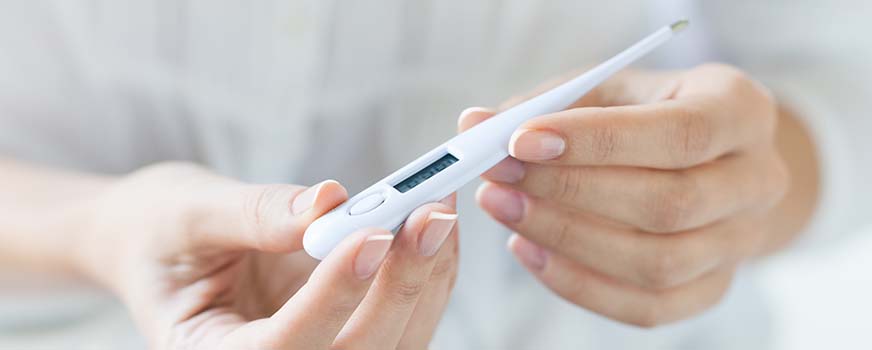Measuring basal body temperature has become an increasingly popular natural family planning method that helps predict days of ovulation. This can be a great addition to your daily fertility health, and when done consistently and accurately, can help you get a better understanding of your ovulation cycle. But what is the basal body temperature method, how is it done, and how accurate is it? Read on to learn more about the method below!
What is the Basal Body Temperature Method?
Basal body temperature (BBT) is the body’s lowest resting temperature, which can be measured as soon as you wake up in the morning. There is a link between ovulation and temperature as a shift in basal body temperature occurs after ovulation takes place in the menstrual cycle due to an increase in progesterone. This shift in resting body temperature can help predict where you are in your cycle.
The basal body temperature method is the tracking of BBT over the course of time to naturally predict the days you are ovulating to find a fertile window. Once there is a change in your recorded temperature of about 0.4°F over a 48-hour period and this shift stays constant for three days or longer, it’s likely an indication of ovulation.
Basal Body Temperature for Natural Family Planning
Basal body temperature tracking is a non-invasive method that requires no medications, hormones, or special equipment (though there are BBT thermometers and tracking apps available to help with the process), and can be paired with other natural family planning methods such as the cervical mucus method to form a more comprehensive picture of your cycle.
Tracking basal body temperature has many benefits in natural family planning, as it can help identify fertile windows for those both trying to conceive and those avoiding pregnancy, and it can also help detect pregnancy:
- If you are tracking your basal body temperature to try to conceive, plan to have sex on your most fertile days. About two days before you expect your basal body temperature to rise, you’ll be at your most fertile. Keep in mind that sperm can survive for up to five days inside your body.
- If you are tracking your basal body temperature to avoid pregnancy, don’t have sex from the first day of your period until several days after your basal body temperature number rises.
- If you are tracking your basal body temperature to detect pregnancy, a rise in basal body temperature that lasts for 18 or more days may be an early indicator of pregnancy.
How to Track Basal Body Temperature
All you need to begin tracking your basal body temperature is a thermometer and some method of tracking your daily readings. Remember to be consistent. Take your temperature first thing every morning at the same time, before you do anything else – movement throughout the day will cause your temperature to rise and can throw off the data. Accuracy is very important to help you get the most reliable results. Taking your BBT and charting it should roughly follow this schedule:
- Every morning before getting out of bed, take your temperature and note it on a chart. You can use a special thermometer designed for basal body temperature, or a digital oral thermometer. You can take an oral, vaginal, or rectal reading. Just be sure to use the same method each time.
- Take your temperature as close to the same time every day as you can. Try to stay within 30 minutes of your average time. You should have a minimum of five hours of sleep before measuring.
- Plot the thermometer number on a chart. You can use a fertility tracking app, or track it yourself. Over time, look for patterns that may emerge.
Risks of Tracking Basal Body Temperature
Basal body temperature can be a helpful tool in family planning, and there are essentially zero risks to taking your temperature. However, it is important to understand that fertility isn’t the only thing that may influence your basal body temperature. Because of this, it can often be unreliable to trust fully when tracking for ovulation. Some women may also ovulate without their basal body temperature fluctuating at all. These additional factors can also have an impact on basal body temperature:
- Alcohol
- Certain medications
- Changes in time zones
- Gynecological disorders
- Illness
- Interrupted sleep cycles
- Shift Work
- Stress
- Travel
Tracking basal body temperature also takes time and dedication for the most accurate results, so it might not be the right method for you if you are looking for a quick or hands-off fertility tracking method.
Next Steps After Tracking Basal Body Temperature
After tracking one complete cycle, review your results. Chart your BBT data for a few months so you can look for patterns and get a better understanding of your ovulation cycle. After you feel more confident in your findings, you can try to plan when to have sex on your fertile days to try to conceive. However, the basal body temperature method isn’t always accurate as cycles can fluctuate. For a fully comprehensive way to monitor your fertility, schedule an appointment with a fertility specialist and bring your basal body temperature findings to your appointment. With this data and the knowledge of your doctor, you’ll be able to have a better understanding of your fertility health and higher chances of conception.





